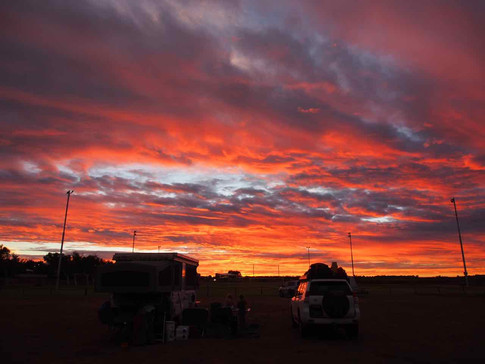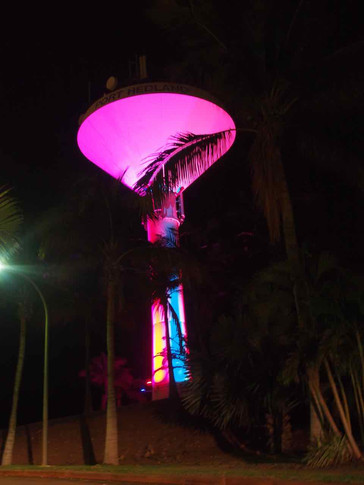PORT HEDLAND, Western Australia
- visited 13 - 14 May 2016 (& 14 - 15 May 2016 at
- May 22, 2016
- 4 min read
We were warned…”Port Hedland is a shithole” was the blunt cautionary advice from traveller after traveller.
Having spent a week free camping near Karijini National Park, we desperately needed food, water and a ‘Dump Easy’ (the emptying point for the porta potti!). Port Hedland was the closest town to offer these essential resources. We initially planned to ‘get in & get out’ within a few hours, then keep travelling to an overnight stop 100km north of the town. Unfortunately, our plans were disrupted by a problem with the Dump Easy, which was undergoing maintenance works. The delay meant we had to stay a night in the “shithole”.
Port Hedland seems to repel travellers, especially those with pets. There are no caravan parks or free camps that allow dogs in the area. However, during ‘peak’ season, the Shire opens up a dusty section of the racing club carpark for us gypsies. Considering most of us spend up big on groceries, fuel and other non-essentials, it’s a travesty that they can’t even provide a basic amenity block to use. I guess our contribution is insignificant compared to the economic windfall from mining.
The racing club was wedged between two main thoroughfares and lay about 1km from the rail line. Each carriage of the impossibly long heavy haul trains groaned slowly along the tracks day and night, laboring under the immense weight of tonnes of iron ore. As night fell and the rumble of daily life slowly faded, it wasn’t long before we became aware of the constant low vibrations from the powerful locomotives tingling underfoot. Our ears rang with the clang of carriages and screech of metal as the 2km long beasts negotiated bends along the tracks. So…the dusty paddock was hardly the most peaceful or picturesque place we’ve stayed but we enjoyed the company of other families we’d met at Karratha so the kids were especially happy!
Driving through Port Hedland there was evidence of the disparate social classes that have an uneasy coexistence in the town. Some areas had incredibly grand residences, each with a pool, new car and boat - a sign of success, of big incomes fed by the mining dollar. Other sections of the Port town were plain depressing. Boards covered shattered windows with monotonous regularity, yards were littered with broken furniture and rusted bric a brac, and dented old cars lined the streets. After talking to the locals, it seemed each group was as angry and afraid of each other. Typically, the younger kids were less affected by the differences, instead finding common ground with local sports, a love of play and a feverish desire to make friends. Unfortunately, it was clear that by high school age, the usual intolerances and discrimination, taught by grown ups they trusted, had been embedded into their psyche and another generation of class war cycled through.
The town’s mining pedigree could be seen everywhere. The Port was a hive of activity with ore being loaded on to enormous ships 24/7. Michael counted 22 more ships waiting in a holding pattern further off shore. Huge machines that transferred loads of cargo from trains to ships filled the horizon and the town’s road and rail infrastructure would have seemed more suited to a city of millions not thousands.
If I had to pick a mining town in the Pilbara to be based, it wouldn’t be Port Hedland. Give me Karratha any day!
Here’s a couple of relevant facts you may find interesting!
Mining companies BHP Billiton, Fortescue Metals, and Rio Tinto operate more than 2,000 kilometres of heavy haulage rail throughout the Pilbara, terminating at 3 main Ports – Port Hedland, Cape Lambert and Dampier
The tracks are the world’s largest privately owned railway network
Individual trains can be more than 2km long and as heavy as 35,000 tonnes
A record breaking train weighed in at 99,734 tonnes and was 7.3 kilometres long. It carried 682 wagons and transported 82,000 tonnes of iron ore
Iron ore is Australia’s largest export commodity, accounting for 23.7% of exports (by value)
Over 94% of Australia’s iron ore exports are sourced from the Pilbara, with the majority of this supplied by three companies— Rio Tinto (who also partners with Hancock Prospecting), BHP Billiton and Fortescue Metals
Australia supplies approximately 40% of the total world iron ore demand
The main importers of Western Australian ore have been China (64%), Japan (21%) and South Korea (10%)
It was with great excitement that we departed Port Hedland, making our way towards Broome - a much anticipated destination. We had intended to take a few days to travel the 600 odd kilometres between the two towns but we ended up with only one overnight stop, primarily due to a lack of dog friendly options along the way. Stanley Rest area, a 24hr roadside stop, had been recommended to us. I think the recommendation had reached every other traveller between Port Hedland and Broome as it was easily the busiest roadside stop we've encountered. It had reasonably good amenities and the few dozen people who camped there the same night as us were all great neighbours. Jesse managed to find some fellow Victorian travellers with kids who shared his love of footy. They kept busy for a few hours playing kick-to-kick while the girls and I played Uno. It certainly wasn't a special location, but it was a great reminder of how practised we've become at the whole set-up caper...I was sitting down with a glass of wine and ready for a game with the kids in only 20 mins. Bliss!
Photos from left to right
Sunrise over our dusty camp ground
A giant iron ore ship in the Port
A massive salt mound
One of the impossibly long trains
One of the shortest trains in Port Hedland! - i was so excited when we stopped at a rail crossing. I thought I'd get a great shot of one of the massive trains rolling past...when it finally came, this is what it looked like! Gave us a giggle.
The Port Hedland Communications tower - the town's so shit, they'll find anything to excite tourists!
A termite mound with a hat...Just outside Port Hedland, there's a section of road where all the termite mounds have been adorned with hats...hard hats, floppy hats, every kind of hat! It's quite funny and breaks up the long drive north.
Sunset at Stanley Rest area

















Comments